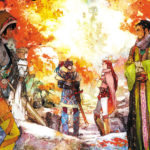‘Dragon Age: Inquisition’ strides into new territory for an expansive, unforgettable journey

By Joe Juba | Game Informer Magazine
DRAGON AGE: INQUISITION
Platform: Microsoft Windows, PlayStation 3, PlayStation 4, Xbox 360, Xbox One
Genre: Action role-playing
Publisher: Electronic Arts
Developer: BioWare
ESRB: M, for Mature
“Dragon Age: Inquisition’s” predecessors — “ Dragon Age: Origins” and “Dragon Age II” — represent two separate visions of the franchise. The first is a sprawling tribute to old-school PC RPGs, while the second is a compact and action-oriented experience tailored to consoles. Though fans may wonder which of those entries Inquisition most resembles, the answer is ultimately irrelevant; Inquisition can’t be reduced to a simple meeting point between two extremes. Instead of trying to reconcile every difference, BioWare strides into new territory for an expansive and unforgettable journey.
Inquisition doesn’t completely forsake its roots; it still blends story, exploration, and combat to bring the adventure to life. While those ideas remain, their execution and seamless connection to each other are unlike anything the series has done before. The nexus of these elements is the Inquisition itself, as you rally the people of Thedas under its banner. As Inquisitor, you perform missions across Orlais and Ferelden, gaining allies and resources to fight a war against an ancient and powerful enemy.
The brilliant part of this concept is how it imbues every activity with purpose. The world of Inquisition is immense, and a freeform structure means everything you accomplish, no matter how small, feeds your larger aspirations. From simple fetch-quests to dragon-slaying expeditions, you are pulled in multiple directions, and each one leads to desirable rewards. I could hardly make it to a single objective marker without getting distracted; I’d stop to claim landmarks, close rifts, and collect crafting materials along the way.
Quests also fold into each other in interesting ways. A simple conversation might open up a new operation on the War Table — the center of your organization where you can send agents off on missions (which finish automatically in real time). If you complete that operation, it may open up a companion quest to undertake with one of your allies, who will appreciate you taking the time and effort to help them. This rabbit hole structure makes it easy to get invested, and the quest variety keeps you from doing the same things over and over. Instead, you just pursue the threads that seem interesting, then reap the rewards.
The payoff for these distractions is the ability to unlock even more new areas, plus earn upgrades (like XP boosts and increased inventory space) for the Inquisition as a whole. This gameplay loop makes distraction easy and lucrative; at the 10-hour mark, I was still exploring the Hinterlands, the first post-prologue area. I finished the game after about 70 hours, and even then, a few zones were left practically untouched.
No matter where it goes, the Inquisition fights resistance from enemy factions. Combat is more in the vein of “Dragon Age II” than “Origins,” with instant-activation abilities mapped to the face buttons. The removal of traditional healing spells is a surprisingly good move, since it prevents you from playing tug-of-war with your health bar and forces you to keep the heat on your foes. The encounter design is more interesting due to the variety of enemies and their different roles, and your allies have fun ways to work together to manage the flow of battle.
Not everything in Inquisition goes off without a hitch. I was annoyed by the lack of a storage chest, especially since my inventory got crowded by upgrades and over-leveled gear – useful items that I was reluctant to sell off. You can expand your inventory via Inquisition perks, but doing so is practically mandatory, which means you burn those points on housekeeping when they could be spent making you feel more powerful.
The world, characters, and side quests of the single-player campaign are bigger and better than ever, but Inquisition doesn’t stop there. The multiplayer mode has you teaming up in four-player co-op for dungeon runs against one of three enemy factions. It captures a kind of excitement similar to Mass Effect 3’s multiplayer, but instead of fighting off waves of encroaching enemies, you are coordinating more precise strategies against a smaller number of foes. These 20-30 minute runs provide a fun twist on a familiar style, and the post-match rewards are great for enticing you to play another round. The maps and classes at launch are plenty to get started, and BioWare has promised continuing support in the form of free DLC in the coming months.
After two disparate entries with different philosophies, “Dragon Age’s” identity crisis is over. With a mixture of open-world exploration, entertaining combat, and top-tier characters, the team at BioWare has found a winning formula that isn’t shackled to either “Dragon Age: Origins” or “Dragon Age II.” “Inquisition” is not defined by the traditions it returns to, but by the new directions it forges for this magnificent fantasy universe.











